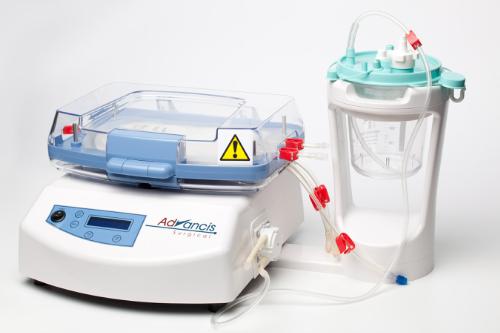If you’re an avid NoCamels reader, you’ll know there are few things we love as much as 3D printing. From 3D-printed cars to 3D-printed shoes and art, we believe this technology will change the world. Now one of the world leaders in the realm of 3D printing, American-Israeli company Stratasys, has partnered with British company Brightwake (Advancis Medical) to make the production of a life-saving and religiously ethical blood collector significantly cheaper.
Hemosep is a one-of-a-kind machine that recovers blood lost or spilled during major trauma and open-heart surgeries, recycling the blood and allowing for its quick transfusion back into the patient. Known as autotransfusion, this process reduces the need for donor blood in a surgery and eliminates any possible complications tied to transfusion reactions. For religious individuals in particular who refuse donor blood, like 50 year-old Jehovah’s Witness UK heart patient Julie Penoyer, Hemosep’s blood recycling technology could be a real life-saver.
Related articles
- How Israeli/American 3D Printing Technology Is Revolutionizing Dentistry
- Israeli Company’s Futuristic Back Implant Can Repair Damaged Spines
In order to create a successful prototype for Hemosep, the people at Brightwake turned to the Stratasys Dimension 1200es 3D printer to create models of some of the device’s central parts, like the filtration and cooling systems. “The Hemosep consists of a bag that uses chemical sponge technology and a mechanical agitator to concentrate blood sucked from a surgical site or drained from a heart-lung machine after surgery,” explains Brightwake’s Director of Research and Development, Steve Cotton. “The cells are then returned to the patient via blood transfusion. In a climate of blood shortage, this recycling methodology has the potential to be a game-changer in the medical industry, saving the National Health Service (NHS) millions,” Cotton continued.
“The future of medical device manufacturing”
 With the desire to get the Hemosep’s live-saving blood recycling technology on the market sooner, Brightwake turned to 3D printed prototype parts to save time and money. Dramatically shortening a production process of three weeks for outsourced products, Brightwake’s in-house use of the Stratasys 3D printer saved the company time and cut its prototyping costs by an astonishing 96 percent, saving about £1000 per piece.
With the desire to get the Hemosep’s live-saving blood recycling technology on the market sooner, Brightwake turned to 3D printed prototype parts to save time and money. Dramatically shortening a production process of three weeks for outsourced products, Brightwake’s in-house use of the Stratasys 3D printer saved the company time and cut its prototyping costs by an astonishing 96 percent, saving about £1000 per piece.
According to Cotton, “3D printing has not only enabled us to cut our own costs, it has also been crucial in actually getting a functional device to clinical trials. The ability to 3D print parts that look, feel and perform like the final product, on-the-fly, is the future of medical device manufacturing.”
Hemosep has already undergone successful clinical trials in over 100 open-heart surgery operations in Turkey and now the technology is being tested in the United Kingdom, primarily on religious patients who refuse the use of donor blood for major operations. While the final Hemosep system will be built from metal and not plastic (a reassuring fact), the need for accuracy, speed and accessibility is what made the creative medical company turn to Stratasys and 3D printing for help – deciding factors which may attract more in medical technology towards the use of printed prototypes.
“In the fast-paced, competitive medical industry, we are seeing more and more of our customers use 3D printing to bring their products to market more efficiently and cost-effectively,” says Andrew Middleton, Senior VP and General Manager of the European Medicines Agency. “The ability to turn ideas into functional products quickly is something that in the long-term we believe will improve the quality of care, and in some cases, save lives.”
Photo: Zdenko Zivkovic
Related posts

Editors’ & Readers’ Choice: 10 Favorite NoCamels Articles

Forward Facing: What Does The Future Hold For Israeli High-Tech?

Impact Innovation: Israeli Startups That Could Shape Our Future




Facebook comments